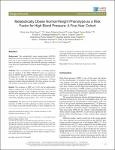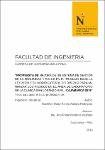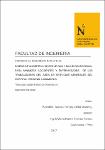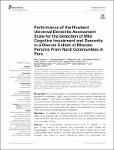| dc.contributor.author | Vera Ponce, Victor Juan | |
| dc.contributor.author | Valencia Guerra, Jame | |
| dc.contributor.author | Torres Malca, Jenny Raquel | |
| dc.contributor.author | Zuzunaga Montoya, Fiorella E. | |
| dc.contributor.author | Loayza Castro, Joan A. | |
| dc.contributor.author | Ponce Guillen, Norka Rocío | |
| dc.contributor.author | Zeñas Trujillo, Gianella Zulema | |
| dc.contributor.author | Valladares Garrido, Mario J. | |
| dc.contributor.author | Munoz Ramos, Willy Cesar | |
| dc.contributor.author | De La Cruz Vargas, Jhony A. | |
| dc.date.accessioned | 2023-10-18T23:32:34Z | |
| dc.date.available | 2023-10-18T23:32:34Z | |
| dc.date.issued | 2023-02-25 | |
| dc.identifier.citation | Vera, V. J., Valencia, J., Torres, J. R., Zuzunaga, F. E., Loayza, J. A., Ponce, N. R., Zeñas, G. Z., Valladares, M. J., Munoz, W. C., & De La Cruz, J. A. (2023). Metabolically Obese Normal-Weight Phenotype as a Risk Factor for High Blood Pressure: A Five-Year Cohort. Journal of Endocrinology and Metabolism, 13(1), 13-19. https://doi.org/10.14740/jem855 | es_PE |
| dc.identifier.other | . | es_PE |
| dc.identifier.uri | https://hdl.handle.net/11537/34625 | |
| dc.description.abstract | Background: The metabolically obese normal-weight (MONW)
phenotype has been considered a risk factor for different chronic diseases, but its role in high blood pressure (HBP) is still unclear. The
aim of the study is to determine if the MONW phenotype constitutes
a risk factor for hypertension in Peruvian adults belonging to a 5-year
cohort.
Methods: This is a retrospective cohort study. A secondary analysis
from the database of the PERU MIGRANT study was carried out
from the MONW and non-MONW cohorts; after a 5-year follow-up,
the appearance of HBP was evaluated in the subjects of both cohorts.
To assess the strength and magnitude of the association, a Poisson
regression model (crude and adjusted) with robust variance was used.
The measure of association was the relative risk (RR).
Results: The incidence of HBP was 11.30%. In the multivariable
analysis, subjects with the MONW phenotype had a 2.879-fold risk
of presenting HBP in 5 years compared with those who were not
MONW at the beginning of the study; this was adjusted for categorized age, sex, group, and state of smoker and alcohol drinker (RR:
2.055; 95% confidence interval (CI): 1.118 - 3.777; P = 0.020).
Conclusions: The presence of the MONW phenotype doubled the
incidence of HBP, even after adjusting for other covariates. However, studies in this field should continue. If these findings are confirmed, it should be considered that presenting an adequate weight
for height should not be interpreted as a condition free of metabolic
alterations, so screening for hypertension should be carried out regardless of whether or not the body mass index obtained is considered normal. | es_PE |
| dc.format | application/pdf | es_PE |
| dc.language.iso | spa | es_PE |
| dc.publisher | Elmer Press | es_PE |
| dc.rights | info:eu-repo/semantics/openAccess | es_PE |
| dc.rights | Atribución-NoComercial-CompartirIgual 3.0 Estados Unidos de América | * |
| dc.rights.uri | https://creativecommons.org/licenses/by-nc-sa/3.0/us/ | * |
| dc.source | Universidad Privada del Norte | es_PE |
| dc.source | Repositorio Institucional - UPN | es_PE |
| dc.subject | Obesidad | es_PE |
| dc.subject | Metabolismo | es_PE |
| dc.subject | Hipertensión | es_PE |
| dc.title | Metabolically Obese Normal-Weight Phenotype as a Risk Factor for High Blood Pressure: A Five-Year Cohort | es_PE |
| dc.type | info:eu-repo/semantics/article | es_PE |
| dc.publisher.country | PE | es_PE |
| dc.identifier.journal | Journal of Endocrinology and Metabolism | es_PE |
| dc.subject.ocde | https://purl.org/pe-repo/ocde/ford#3.03.04 | es_PE |
| dc.description.sede | San Juan de Lurigancho | es_PE |
| dc.identifier.doi | https://doi.org/10.14740/jem855 | |







